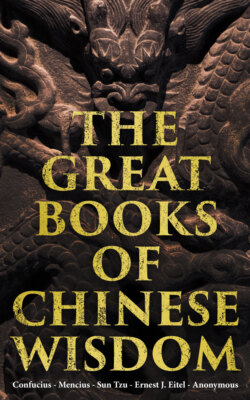Читать книгу The Great Books of Chinese Wisdom - Mencius - Страница 54
ОглавлениеHexagram XXXVIII.38 Khwei
Khwei indicates that, (notwithstanding the condition of things which it denotes), in small matters there will (still) be good success.
1. The first line, undivided, shows that (to its subject) occasion for repentance will disappear. He has lost his horses, but let him not seek for them;--they will return of themselves. Should he meet with bad men, he will not err (in communicating with them).
2. The second line, undivided, shows its subject happening to meet with his lord in a bye-passage. There will be no error.
3. In the third line, divided, we see one whose carriage is dragged back, while the oxen in it are pushed back, and he is himself subjected to the shaving of his head and the cutting off of his nose. There is no good beginning, but there will be a good end.
4. The fourth line, undivided, shows its subject solitary amidst the (prevailing) disunion. (But) he meets with the good man (represented by the first line), and they blend their sincere desires together. The position is one of peril, but there will be no mistake.
5. The fifth line, divided, shows that (to its subject) occasion for repentance will disappear. With his relative (and minister he unites closely and readily) as if he were biting through a piece of skin. When he goes forward (with this help), what error can there be?
6. The topmost line, undivided, shows its subject solitary amidst the (prevailing) disunion. (In the subject of the third line, he seems to) see a pig bearing on its back a load of mud, (or fancies) there is a carriage full of ghosts. He first bends his bow against him, and afterwards unbends it, (for he discovers) that he is not an assailant to injure, but a near relative. Going forward, he shall meet with (genial) rain, and there will be good fortune.
Footnotes
38. Khwei denotes a social state in which division and mutual alienation prevail, and the hexagram teaches how in small matters this condition may be healed, and the way prepared for the cure of the whole system. The writer or writers of Appendixes I and II point out the indication in the figure of division and disunion according to their views. In Appendix VI those things appear as a necessary sequel to the regulation of the family; while it is impossible to discover any allusion to the family in the Text.
Line 1 is strong, and in an odd place. A successful course might be auspiced for its subject; but the correlate in line 4 is also strong; and therefore disappointment and repentance are likely to ensue. In the condition, however, indicated by Khwei, where people have a common virtue, they will help one another. Through the good services of 4, the other will not have to repent. His condition may be emblemed by a traveller's loss of his horses, which return to him of themselves.
Should he meet with bad men, however, let him not shrink from them. Communication with them will be of benefit. His good p. 141 may overcome their evil, and at least it will help to silence their slanderous tongues.
Line 5 is weak, and its subject is the proper correlate of the strong 2. They might meet openly; but for the separation and disunion that mark the time. A casual, as it were a stolen, interview, as in a bye-lane or passage, however will be useful, and may lead on to a better understanding.
Line 3 is weak, where it ought to be strong. Its correlate, however, in 6 is strong, and the relation between them might seem what it ought to be. But the weak 3 is between the strong lines in 2 and 4; and in a time of disunion there ensue the checking and repulsion emblemed in the Text. At the same time the subject of line 6 inflicts on that of 3 the punishments which are mentioned. It is thus bad for 3 at first, but we are told that in the end it will be well with him; and this will be due to the strength of the sixth line. The conclusion grows out of a conviction in the mind of the author that what is right and good is destined to triumph over what is wrong and bad. Disorder shall in the long run give place to order, and disunion to union.
Line 4 has no proper correlate, and might seem to be solitary. But, as we saw on line 1, in this hexagram, correlates of the same class help each other. Hence the subjects of 4 and 1, meeting together, work with good will and success.
The place of 5 is odd, but the line itself is weak, so that there might arise occasion for repentance. But the strong 2 is a proper correlate to the weak 5. Five being the sovereign's place, the subject of 2 is styled the sovereign's relative, of the same surname p. 142 with him, and head of some branch of the descendants of the royal house. It is as easy for 5, so supported, to deal with the disunion of the time, as to bite through a piece of skin.
Line 6 is an even place, and yet the line is strong;--what can its subject effect? He looks at 3, which, as weak, is a proper correlate; but he looks with the evil eye of disunion. The subject of 3 appears no better than a filthy pig, nor more real than an impossible carriage-load of ghosts. He bends his bow against him, but he unbends it, discovering a friend in 3, as x did in 4, and 5 in 2. He acts and with good luck, comparable to the falling rain, which results from the happy union of the yang and yin in nature.
